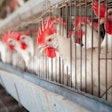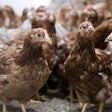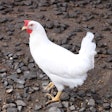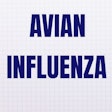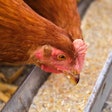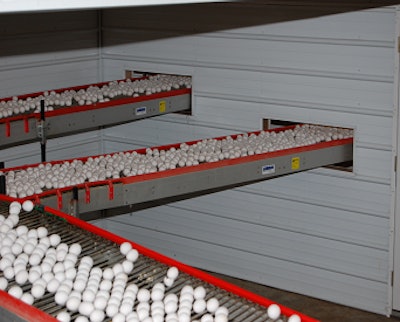
The U.S. Food and Drug Administration publishes on its website the warning letters that it sends to companies whose facilities its staff has inspected and found to be deficient. Since the FDA began inspecting egg farms in September of 2010 to monitor compliance with the Egg Safety Rule, the agency reports that its staff and delegated state agencies have conducted 555 inspections of egg farms, each with 50,000 or more layers. As a result of these inspections, the FDA issued a total of 11 warning letters to egg producers, eight in calendar year 2012 and three in calendar year 2011. Some of the warning letters were sent to egg companies that have multiple farms, and the letters documented issues at more than one location.
The deficiencies documented in these warning letters can be summarized into a few general categories: the farm’s egg safety plan doesn’t meet the regulations, documentation errors, failure to adequately respond to documented deficiencies, and poor pest management. A closer look at examples of the deficiencies cited may help egg producers to avoid similar problems.
Know the Egg Safety Rule
It may sound silly to say that egg producers should double check to make sure their egg safety program for each farm meets all of the requirements of the Egg Safety Rule, but several of the farms receiving warning letters had plans that did not meet all of the requirements. A common problem was that biosecurity measures that are taken by workers on the farm to prevent the spread of Salmonella enteritidis from one house to another on a farm were not spelled out in the program. Another deficiency cited in several letters was the lack of cleaning and disinfection procedures for pullet houses if an environmental Salmonella enteritidis-positive sample was found or for the layer house with a Salmonella enteritidis-positive egg sample.
Companies with multiple farm sites need to make sure that the egg safety plans they develop are appropriately modified to fit each specific farm location and each layer house. Many parts of the egg safety plan will be the same between farms and houses, but things like the plans for environmental sampling and pest control sampling will vary depending on house size and layout. It is important to remember that each farm needs its own egg safety plan, and it must have the farm name, location and be signed by the appropriate personnel.
Documentation is critical
Egg safety plans need to spell out exactly what employees are required to do, and then employees need to perform the required actions and appropriately document what has been done. Several of the warning letters cited documentation issues. The most common and easiest to correct are cases where signatures, dates and or times do not appear on the paperwork in the appropriate place. All employees need to be trained about the importance of documenting checks immediately and doing the documentation completely. Without appropriate documentation, it is as if the check wasn’t made.
One area where documentation was lacking at multiple farms was the documentation of egg cooler temperatures. Eggs are required to be stored in a cooler that is 45F or less within 36 hours of lay. Some egg farms were not documenting cooler temperatures. Other operations were using refrigerated trailers for storage and transport of eggs, but were not documenting trailer temperatures.
Follow your plan
Several farms that received warning letters were not taking environmental samples looking for Salmonella enteritidis at the appropriate time or in the manner called for in the Egg Safety Rule. Several farms did not take the required environmental samples when the pullets were 14 to 16 weeks of age. Multiple farms did not collect the required environmental samples from houses where layers were molted at the required four to six weeks post molt. Also, a few farms missed the required environmental house sampling when the layers reached 40 to 45 weeks of age.
Another issue cited on multiple farms by the FDA was the pooling of environmental samples on Salmonella enteritidis tests. The pooling of samples is not allowed by the FDA at this time, although the egg industry is working with researchers and the FDA to test this method, and an approved protocol for pooling environmental samples may be forthcoming.
Take appropriate corrective action
If your farm has an egg safety program that meets all of the requirements of the Egg Safety Rule, your personnel are trained to perform the necessary checks and document them appropriately, and the checks are done at the appropriate times, you have only completed the easy part of the process. The next step is responding to checks that are out of bounds in an appropriate and effective manner. In short, you still have to manage your farm.
The most common problem cited in the FDA warning letters to egg producers was inadequate pest control. Flies were a problem at a few of the farms, but rodents were a problem at many of the farms. Clutter and excessive vegetation around the houses, which can provide harborage for rodents, were cited at multiple farms as a deficiency. Poor maintenance of the exteriors of buildings, which allows access to rodents and other unwanted visitors like birds, cats and other wild animals, was cited in many of the warning letters. The FDA requires that stray animals, like cats, be excluded from houses as well as wild animals, like field mice and sparrows. One warning letter specifically stated that an egg safety program for a farm must address stray animals, not just wild ones.
If your check of traps yields a rodent index above the acceptable standard, then effective action must be taken to reduce rodent numbers. Workers cannot just keep doing what they have always done just because that is the way it has been done on that farm in the past. If a stated corrective action doesn’t effectively reduce the number of rodents found on subsequent tests, then a different corrective action should be taken. It is not considered acceptable to just continue to employ the same corrective action repeatedly if it doesn’t achieve the desired objective.
Employees who work on farms that have had a history of relatively high rodent numbers can become accustomed to rodent populations on the farm, which are considered excessive from a Salmonella prevention standpoint. Under these circumstances, farm management will have to stress to employees that what used to be status quo is no longer acceptable, and that everyone needs to be committed to striving for virtually rodent-free farms. Good pest management requires a strong commitment of management and employees to achieve the desired results. Don’t hesitate to seek outside help to design a program that will work for your farm.
Review your program
Under the Egg Safety Rule, egg producers are required to periodically review their egg safety plan. The review process should not be undertaken as a mere formality. Egg producers should take this opportunity to review their records and look at what has worked and what hasn’t. Make sure any changes in your houses or how you raise and house birds are reflected in your program. Pay particular attention to things like the age you plan on moving pullets, or if you are molting your birds. Remember, you need to conduct environmental sampling at the designated bird ages, even if you move birds at an earlier age.
If you are the person who originally drafted your egg safety plan, it might be beneficial to have someone else look at your plan as part of the review process. Sometimes a new set of eyes can see things that we can’t if we live with the program every day.








